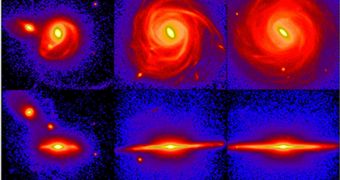Using advanced modeling techniques, as well as data collected from a survey of several stars neighboring the Sun, a team of astronomers was recently able to reconstruct the evolutionary history of the Milky Way, and determine that the galaxy shook, stirred and vibrated as it formed.
The investigation was led by astronomer Ivan Minchev, who holds an appointment with the Leibniz Institute for Astrophysics Potsdam (AIP). For this research, the team focused on analyzing the vertical motions of stars, those that were perpendicular to the galactic disk.
The group also looked into how these motion patterns correlated with the age of each individual star. Instead of spending a lot of time analyzing the age of each star, scientists used the chemical composition of these objects as an indicator of age.
The simplest indicator was the ratio of magnesium to iron ([Mg/Fe]) present in these objects. This information was collected from the RAdial Velocity Experiment (RAVE), which surveys an important amount of stars neighboring the Sun.
The group found that stars with higher [Mg/Fe] ratios did not exhibit higher and faster vertical motions, as some theories had suggested. In fact, the high metallicity of such objects could be correlated with a much lower movement speed.
A computer simulation of the Milky Way – which the team ran in order to try and explain their results – revealed that past collisions with dwarf galaxies may be responsible for these readings. Our galaxy is believed to have undergone several such clashes earlier on in its history.
The collision had another interesting effect as well – they have led to the formation of the galactic spiral arms our Milky Way boasts today, and pushed a massive number of stars away from the galactic center to the outer halo. Experts estimate the entire galaxy shook and vibrated uncontrollably as this happened.
Based on measurements of stars displays low vertical velocity values, AIP investigators determined that the Milky Way collides with more dwarf galaxies than other studies had predicted before.
“Our results will enable us to trace the history of our home Galaxy more accurately than ever before. By looking at the chemical composition of stars around us, and how fast they move, we can deduce the properties of satellite galaxies interacting with the Milky Way throughout its lifetime,” Minchev says.
“This can lead to an improved understanding of how the Milky Way may have evolved into the Galaxy we see today,” the expert concludes. Details of the investigation appear in the January 20 issue of the esteemed Astrophysical Journal Letters.

 14 DAY TRIAL //
14 DAY TRIAL //